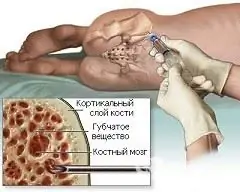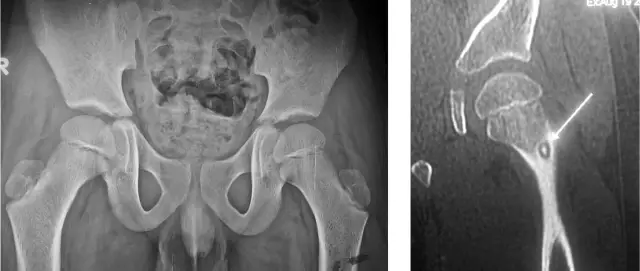- Author Rachel Wainwright [email protected].
- Public 2023-12-15 07:39.
- Last modified 2025-11-02 20:14.
Bone marrow transplant

By inertia, we continue to believe that bone marrow transplantation is the newest method of treatment, while more than half a century has passed since this procedure was performed for the first time. For the first time, successful bone marrow transplantation was performed in 1968, and taking into account the first attempts that were not very successful (started in the 50s of the twentieth century), this method of treatment can be considered almost a classic.
Today, bone marrow and stem cell transplantation is one of the most effective methods of treating malignant blood diseases and severe conditions caused by bone marrow suppression by radiation, chemotherapy, or the action of toxic substances. This is an extreme case, the last chance method. They resort to it when other methods have been tried several times, and they did not help. There are several reasons for this. First, transplantation is associated with great risks for the body; it is justified when it is absolutely clear that without it the patient will surely die. And secondly, it is a very expensive procedure. The cost of transplantation in Western clinics is about 100 thousand dollars.
The principle of the method
In short, the essence of the method is as follows. Bone marrow contains a large number of stem cells - that is, precursor cells from which the rest of the body's cells, in particular, blood, subsequently develop. Affected by a malignant process, the bone marrow produces blast cells, that is, immature and incapable of maturation. When there is no longer any hope of restoring bone marrow function, they resort to stem cell transplantation. Before that, your own bone marrow cells are destroyed by massive doses of radiation or chemotherapy. Such a procedure gives hope that new stem cells will take root in a new place and will be involved in the production of healthy blood cells, and this hope is often justified.
In bone marrow transplantation, as in transplantation of other organs, there are pitfalls, the main of which is the rejection of foreign cells by the body, or the aggressive behavior of these same foreign cells in relation to the body. These two types of reactions in transplantology are known as graft rejection (GR) and graft-versus-host disease (GVHD). They pose a serious threat to life, and in order to keep these unwanted immune responses to a minimum, the transplanted cells must be as compatible with the host's cells as possible.
Types of bone marrow transplants
Full compatibility is possible only in one case, if you transplant your own cells. This type of transplant is called autologous. In this case, his own bone marrow cells are taken from the patient, cleansed of the admixture of diseased cells, and then returned to the circulatory system.
A transplant from someone else's donor is called an allogeneic transplant. In this case, the donor that is maximally compatible with the patient is selected, using the database of special donor banks.
A special type of allogeneic transplant is a synergistic transplant, or transplantation of cells taken from an identical twin. In this case, although the donor is another person, the cell compatibility is very high, although not one hundred percent.
In the case of allogeneic transplantation, the patient will have to take immunosuppressants for the rest of his life - drugs that suppress the immune response to the presence of a foreign protein in the body. However, this is an acceptable price for the saved life.
Preparing for a bone marrow transplant
Bone marrow transplantation can be divided into three stages.
The first stage is preparatory. The patient is prepared for a transplant by exposing his bone marrow to increased doses of radiation, or by using cytostatic drugs, that is, those drugs that are usually used for chemotherapy, at higher doses. Since that time and throughout the treatment with this method, the patient is in strict isolation from everyone except the medical staff; moreover, conditions of complete sterility are maintained in his ward, like in an operating room. These measures are necessary to protect him from infection, since the immune system, with the loss of the bone marrow of its functions, is virtually disabled.

The preparatory process includes the collection of donor bone marrow cells, of course, after passing diagnostics, in particular, a number of tests confirming compatibility. The procedure is performed under general anesthesia. A large amount of bone marrow is contained in the tibia and ilium, so they take it from there. The bone is pierced with a thick needle and 950 ml to 2000 ml of a mixture of bone marrow and blood is aspirated. This amount does not pose any threat to the health of the donor. His bone marrow volume will fully recover after a while. After recovery from anesthesia, there may be discomfort in the bones, similar to the aching pain from a bruise, however, the pain is not intense. After 1-2 days, the donor can continue to lead a normal life.
The extracted bone marrow is frozen at ultra-low temperatures and stored in this way until transplantation. Your own bone marrow is cleared of cancer cells, and bone marrow from a donor donor is sometimes cleared of immune cells to reduce the risk of rejection.
Bone marrow transplant procedure
Many people mistakenly believe that bone marrow transplant is a surgical operation. In fact, this is not an operation, but a procedure that does not require anesthesia. It is similar to a conventional blood transfusion: a catheter is inserted into a large vessel in the neck through which the bone marrow substrate is slowly infused into the patient's bloodstream, from where it will penetrate into the bone marrow tissue. During the procedure, doctors monitor the patient's condition. Of all the stages of transplantation, this one is the most uncomplicated in comparison with the rest.
The final stage of transplantation
Perhaps the most difficult period, especially emotionally. If you describe it in one word, then this word will be "expectation." Intense expectation and constant monitoring of the state of the body, and hope, great hope that labor and suffering will not be in vain, and that the bone marrow will take root.
The bone marrow transplant procedure requires a lot of courage from the patient and those close to him. All the time of transplantation, starting from the preparatory stage, a person is accompanied by nausea, extreme weakness, feeling unwell and other unpleasant symptoms, and they can last for months. The hospital environment and isolation do not add to the positive mood either, and yet this is what is required. It takes a desire to live, a desire to conquer disease, courage and fortitude, and these are not empty big words - according to the testimony of doctors, the largest number of successful transplants were performed precisely for those patients who possess these qualities and are able to fight, no matter what.
Currently, tens of thousands of people with bone marrow transplants live in the world.
Found a mistake in the text? Select it and press Ctrl + Enter.






